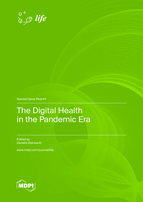The Digital Health in the Pandemic Era
A special issue of Life (ISSN 2075-1729). This special issue belongs to the section "Epidemiology".
Deadline for manuscript submissions: closed (30 April 2023) | Viewed by 37908
Special Issue Editor
Interests: robotics; artificial intelligence; neural networks; mHealth; digital health; rehabilitation; eHealth; smart technology; cybersecurity; informatics; Big Data; mental health; animal-assisted therapy; telemedicine; social robotics; acceptance; diagnostic and interventional radiology; medical imaging
Special Issues, Collections and Topics in MDPI journals
Special Issue Information
Dear Colleagues,
Digital health, virtual assistance and telemedicine are terms often used interchangeably to refer to remote medical assistance, monitoring and care. Several studies and insights published during 2020 have developed these issues, analyzing the advantages and disadvantages, successes and failures and offering reflections on the implications and issues of these technologies in the health domain. The results of these investigations will affect the redesign of hospital and outpatient management based on digital innovation using eHealth and mHealth.
Digital health encompasses a broad spectrum of technologies, including wearable personal devices and internal devices, as well as various types of sensors and innovative solutions. Digital health can help identify risks and correct assistance in the diagnosis, treatment and monitoring of health conditions, offering new potential both to the population and the insiders of the health domain. During the pandemic, this approach made it possible to offer assistance and continue care at home, protecting patients, preserving health workers, limiting the spread of the virus and reducing the need for hospitalization. For example, in recent months the opportunity to make digital measurements of oxygen saturation at home has been used to make fundamental decisions for the health of patients, such as the choice between hospitalization and respiratory support. It has also become possible to monitor frail patients from home (e.g., with diabetes, cardiovascular or oncological problems) improving the continuity of care and reducing the pressure on the hospitals. Digital Health also continues to contribute to the fight against the pandemic in various new ways, such as the management of digital contact tracing and vaccination processes through smart technology. The following topics, though not exhaustive, will be considered: innovations in the field, including those related to the COVID-19 pandemic; the acceptance of Digital Health to all those involved, from the healthcare professionals to the patients; applications during the pandemic; successes and failures.
This Special Issue of Healthcare welcomes commentaries, original research, short reports, opinions, viewpoints, project reports, perspectives, communications, comments, editorials and reviews on the challenges faced by digital health in the health domain in the pandemic era.
Dr. Daniele Giansanti
Guest Editor
Manuscript Submission Information
Manuscripts should be submitted online at www.mdpi.com by registering and logging in to this website. Once you are registered, click here to go to the submission form. Manuscripts can be submitted until the deadline. All submissions that pass pre-check are peer-reviewed. Accepted papers will be published continuously in the journal (as soon as accepted) and will be listed together on the special issue website. Research articles, review articles as well as short communications are invited. For planned papers, a title and short abstract (about 100 words) can be sent to the Editorial Office for announcement on this website.
Submitted manuscripts should not have been published previously, nor be under consideration for publication elsewhere (except conference proceedings papers). All manuscripts are thoroughly refereed through a single-blind peer-review process. A guide for authors and other relevant information for submission of manuscripts is available on the Instructions for Authors page. Life is an international peer-reviewed open access monthly journal published by MDPI.
Please visit the Instructions for Authors page before submitting a manuscript. The Article Processing Charge (APC) for publication in this open access journal is 2600 CHF (Swiss Francs). Submitted papers should be well formatted and use good English. Authors may use MDPI's English editing service prior to publication or during author revisions.
Keywords
- Digital Health
- Covid-19
- mHealth
- contact tracing
- telemedicine
- virtual care
- pandemic
- eHealth







